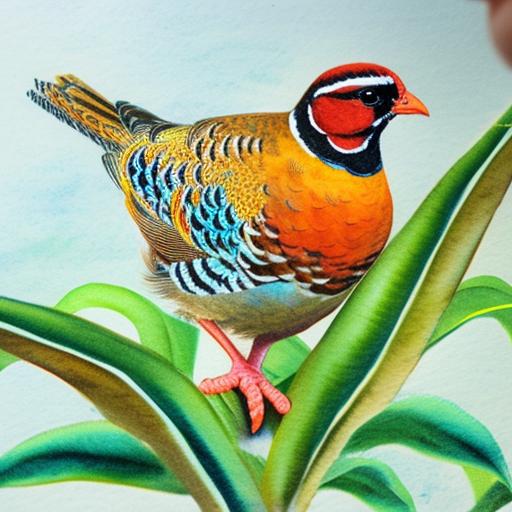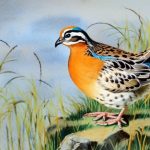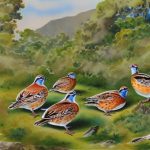Jungle Bush Quail, also known as Perdicula asiatica, are small, ground-dwelling birds that are native to the Indian subcontinent. These birds are known for their beautiful plumage and distinctive calls, making them a popular choice for aviculture enthusiasts. Breeding Jungle Bush Quail can be a rewarding and fulfilling experience, but it requires careful planning, dedication, and knowledge of the species’ habitat, behavior, and breeding requirements. In this article, we will explore the various aspects of Jungle Bush Quail breeding, including understanding their habitat and behavior, selecting the right breeding stock, creating the ideal breeding environment, breeding techniques and practices, caring for chicks and juveniles, as well as the challenges and considerations involved in breeding these fascinating birds.
Key Takeaways
- Jungle bush quail breeding requires understanding the habitat, behavior, and breeding techniques specific to this species.
- The ideal breeding stock for jungle bush quail should be selected based on health, genetics, and behavior.
- Creating the right breeding environment for jungle bush quail involves providing suitable nesting areas, food, and protection from predators.
- Breeding techniques for jungle bush quail include natural mating, artificial insemination, and proper egg incubation and brooding.
- Caring for jungle bush quail chicks and juveniles involves providing proper nutrition, warmth, and protection from predators.
Understanding the Habitat and Behavior of Jungle Bush Quail
Jungle Bush Quail are typically found in dry grasslands, scrub forests, and agricultural fields with dense vegetation in India, Nepal, and Sri Lanka. They are ground-dwelling birds that prefer to forage for seeds, insects, and small invertebrates in the undergrowth. Understanding their natural habitat is crucial for successfully breeding Jungle Bush Quail in captivity. When designing the breeding environment, it is important to replicate their natural habitat as closely as possible. This includes providing dense vegetation, hiding spots, and suitable foraging areas within the enclosure. Additionally, Jungle Bush Quail are known for their secretive and shy nature, so providing them with plenty of cover and privacy is essential for their well-being and breeding success. Observing their behavior in the wild can also provide valuable insights into their social structure, mating rituals, and nesting habits, which can be useful for creating a conducive breeding environment in captivity.
Selecting the Right Breeding Stock for Jungle Bush Quail
Selecting the right breeding stock is crucial for establishing a successful breeding program for Jungle Bush Quail. When choosing breeding pairs, it is important to select healthy, unrelated birds with strong genetic traits. Look for birds that exhibit vibrant plumage, good body conformation, and active behavior. Avoid birds with any signs of illness or deformities, as these traits can be passed on to their offspring. It is also important to consider the birds’ age and breeding history when selecting breeding stock. Younger birds may take longer to reach sexual maturity and may have lower fertility rates, while older birds may have reduced reproductive capabilities. It is also advisable to obtain birds from reputable breeders or sources to ensure that they have been properly cared for and are free from any diseases or parasites that could jeopardize the breeding program.
Creating the Ideal Breeding Environment for Jungle Bush Quail
Creating the ideal breeding environment for Jungle Bush Quail is essential for their reproductive success. The breeding enclosure should be spacious enough to accommodate the breeding pairs and provide ample room for natural behaviors such as foraging, dust bathing, and courtship displays. The enclosure should be planted with dense vegetation such as grasses, shrubs, and small trees to provide cover and nesting sites for the quail. Providing a variety of natural materials such as dried grasses, twigs, and leaves can encourage the quail to build their own nests. Additionally, the enclosure should have a suitable substrate for nesting, such as sandy soil or peat moss. It is important to provide a balanced diet that includes seeds, grains, insects, and fresh greens to ensure that the quail are in optimal breeding condition. Access to clean water for drinking and bathing is also essential for their overall health and reproductive success.
Breeding Techniques and Practices for Jungle Bush Quail
Breeding Jungle Bush Quail requires careful observation and monitoring of the breeding pairs to ensure that they are in optimal breeding condition. During the breeding season, males will often display courtship behaviors such as calling, puffing up their feathers, and performing elaborate mating dances to attract females. It is important to provide the quail with privacy and minimal disturbance during this time to encourage natural mating behaviors. Once mating has occurred, the female will seek out a suitable nesting site within the enclosure to lay her eggs. It is important to provide nesting materials such as dried grasses and leaves to facilitate nest building. The eggs should be collected daily to prevent them from being damaged or eaten by the quail or other animals in the enclosure. The eggs can be artificially incubated using a specialized incubator or left in the care of the female quail to hatch naturally. Providing a quiet and stress-free environment during the incubation period is crucial for the successful hatching of the eggs.
Caring for Jungle Bush Quail Chicks and Juveniles

Once the eggs have hatched, caring for Jungle Bush Quail chicks and juveniles requires special attention and care. The chicks should be kept in a warm and draft-free brooder with access to fresh water and a high-quality game bird starter feed. It is important to monitor their growth and development closely to ensure that they are thriving and receiving adequate nutrition. As they grow, they can be gradually introduced to the outdoor enclosure under supervision to acclimate them to their new environment. Providing plenty of hiding spots and cover within the enclosure can help protect the young quail from predators and encourage natural behaviors such as foraging and dust bathing. It is important to monitor their interactions with adult quail to prevent any aggression or bullying. Additionally, regular health checks and parasite control are essential for maintaining the overall well-being of the chicks and juveniles.
Challenges and Considerations in Jungle Bush Quail Breeding
Breeding Jungle Bush Quail can present various challenges and considerations that breeders should be aware of. One of the main challenges is ensuring that the breeding pairs are compatible and exhibit natural mating behaviors. Some pairs may require additional time or encouragement to form a bond and successfully mate. Additionally, providing a suitable nesting environment that meets the quail’s preferences can be challenging, as some individuals may be more selective about their nesting sites. Another consideration is managing aggression within the breeding groups, as male quail can become territorial and aggressive towards each other during the breeding season. Providing ample space and hiding spots within the enclosure can help minimize aggressive behaviors. Finally, maintaining optimal environmental conditions such as temperature, humidity, and lighting within the breeding enclosure is crucial for promoting reproductive success and ensuring the health of the quail.
In conclusion, breeding Jungle Bush Quail can be a rewarding endeavor for aviculture enthusiasts who are passionate about conserving this unique species. By understanding their natural habitat and behavior, selecting the right breeding stock, creating an ideal breeding environment, implementing effective breeding techniques and practices, caring for chicks and juveniles, as well as addressing potential challenges and considerations, breeders can contribute to the conservation of this fascinating species while enjoying the fulfillment of successful breeding outcomes.
If you’re interested in learning more about creating the ideal environment for breeding jungle bush quail, you might also want to check out this article on producers pride sentinel chicken coop. It provides valuable insights into creating a safe and comfortable space for your quail to thrive and reproduce.
FAQs
What is jungle bush quail breeding?
Jungle bush quail breeding refers to the process of breeding and raising jungle bush quails in captivity for conservation, research, or commercial purposes.
Why breed jungle bush quails in captivity?
Breeding jungle bush quails in captivity can help conserve the species, provide research opportunities, and meet the demand for these birds in the commercial market.
What are the key considerations for breeding jungle bush quails?
Key considerations for breeding jungle bush quails include providing suitable habitat, proper nutrition, veterinary care, and ensuring genetic diversity within the breeding population.
What is the breeding season for jungle bush quails?
The breeding season for jungle bush quails typically occurs during the monsoon months, from June to September, in their natural habitat.
What are the challenges of breeding jungle bush quails in captivity?
Challenges of breeding jungle bush quails in captivity may include replicating their natural habitat, preventing inbreeding, and ensuring the birds exhibit natural behaviors.
Are there any regulations or permits required for breeding jungle bush quails?
Depending on the location and purpose of breeding, there may be regulations and permits required for breeding jungle bush quails, especially if it involves conservation or commercial activities.
Meet Walter, the feathered-friend fanatic of Florida! Nestled in the sunshine state, Walter struts through life with his feathered companions, clucking his way to happiness. With a coop that’s fancier than a five-star hotel, he’s the Don Juan of the chicken world. When he’s not teaching his hens to do the cha-cha, you’ll find him in a heated debate with his prized rooster, Sir Clucks-a-Lot. Walter’s poultry passion is no yolk; he’s the sunny-side-up guy you never knew you needed in your flock of friends!







